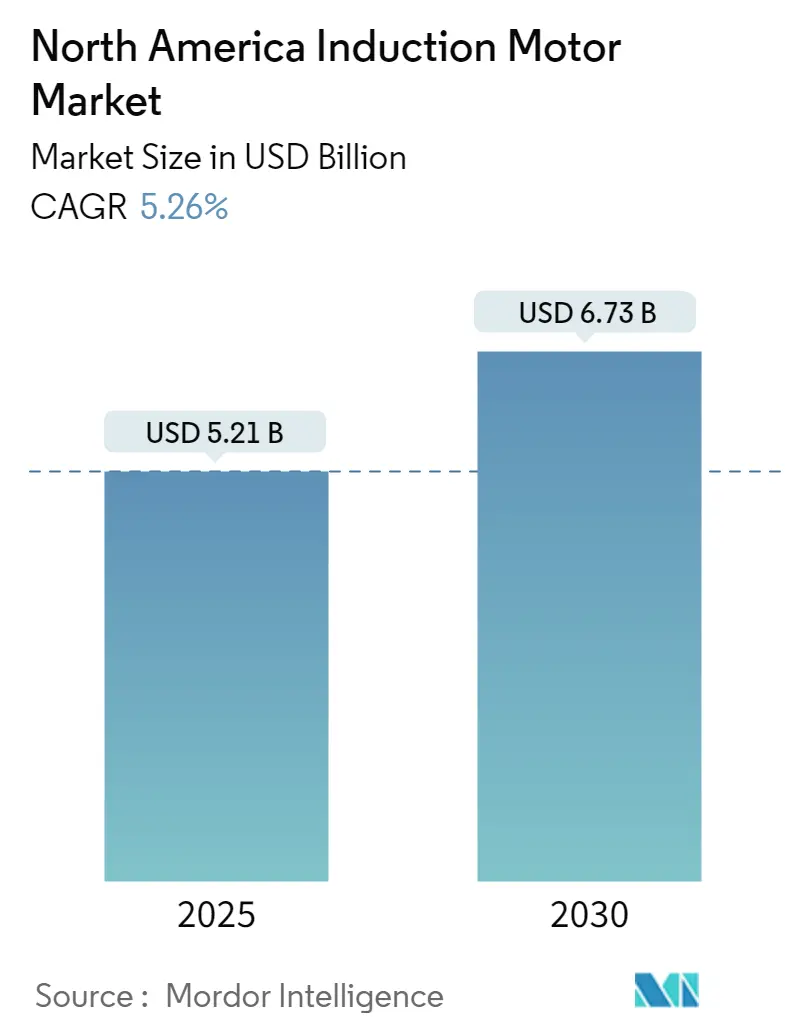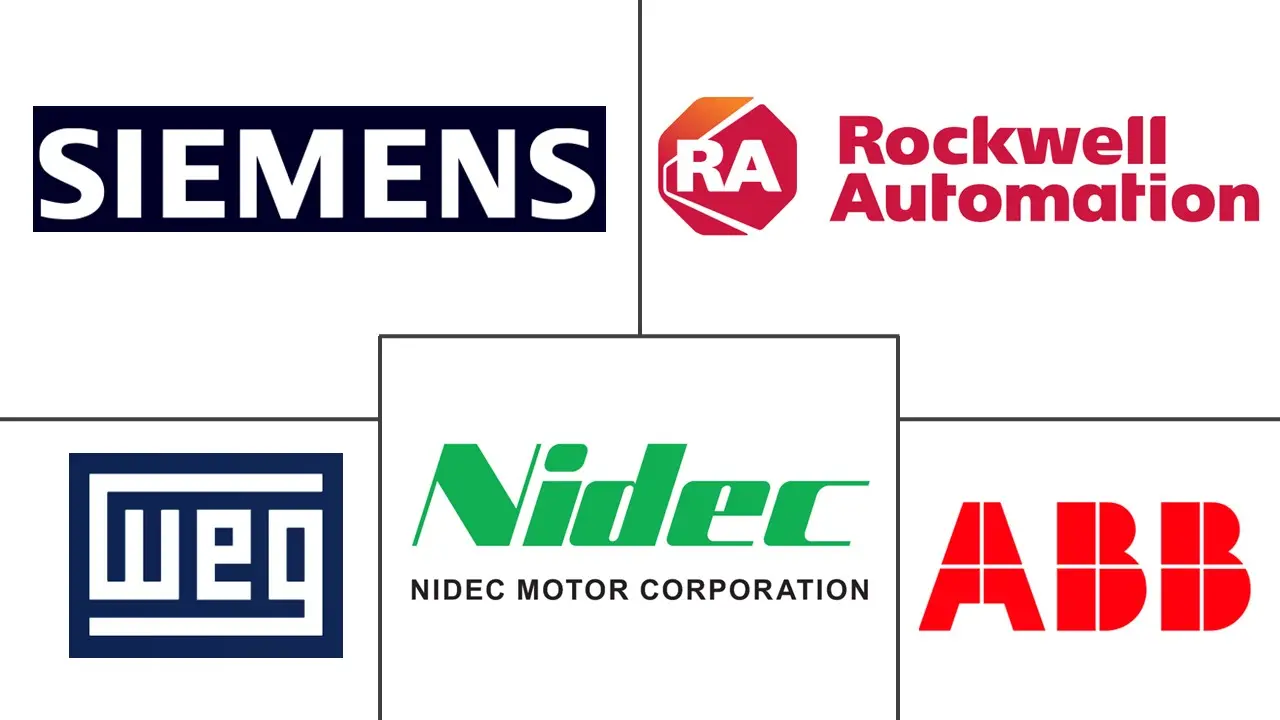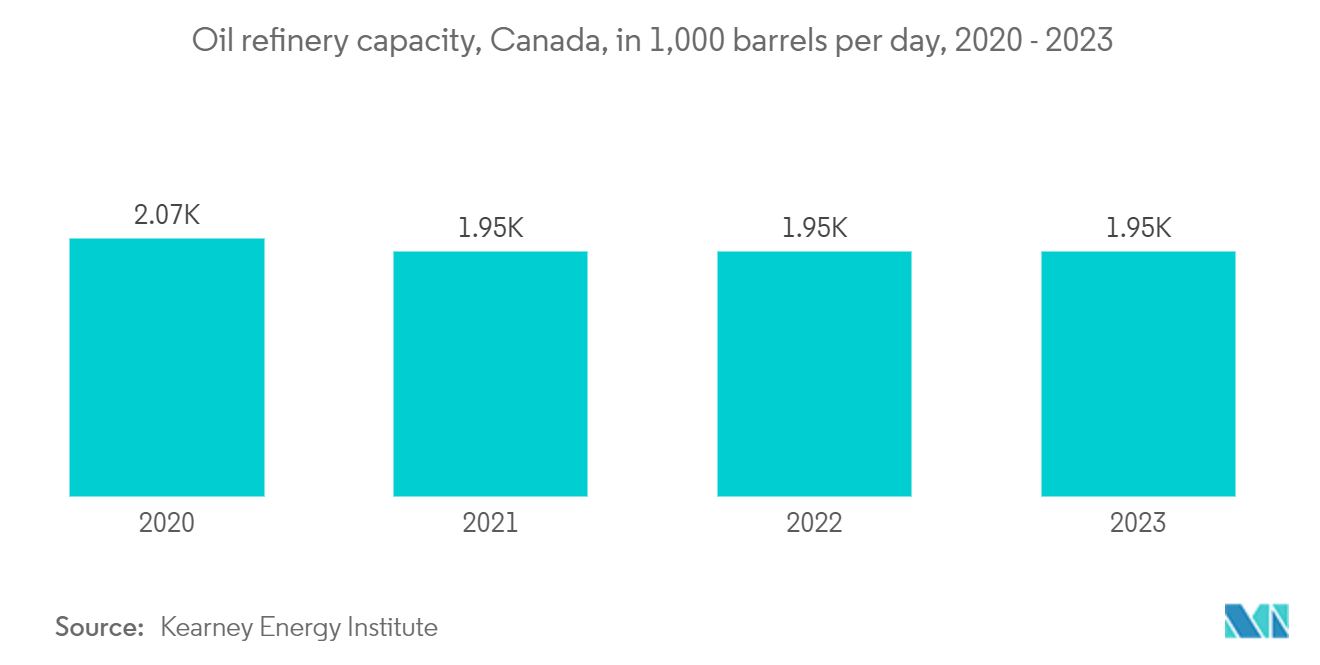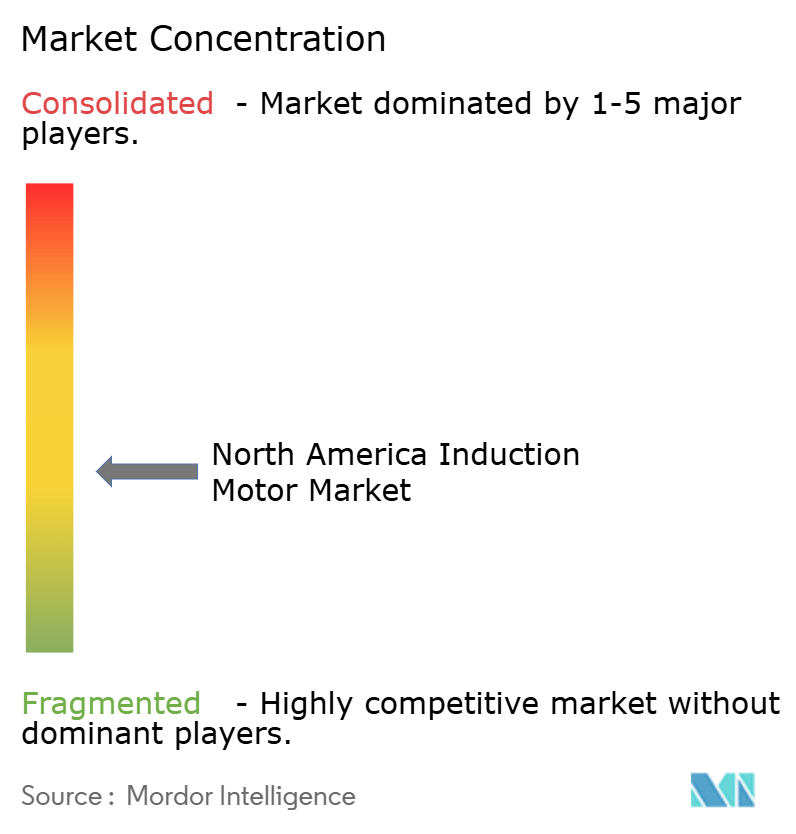
| Study Period | 2019 - 2030 |
| Base Year For Estimation | 2024 |
| Forecast Data Period | 2025 - 2030 |
| Market Size (2025) | USD 5.21 Billion |
| Market Size (2030) | USD 6.73 Billion |
| CAGR (2025 - 2030) | 5.26 % |
| Market Concentration | Medium |
Major Players
*Disclaimer: Major Players sorted in no particular order |
North America Induction Motor Market Analysis
The North America Induction Motor Market size is estimated at USD 5.21 billion in 2025, and is expected to reach USD 6.73 billion by 2030, at a CAGR of 5.26% during the forecast period (2025-2030).
- The North American induction motors market is experiencing robust growth, driven by increasing demand for energy-efficient motors across various industries. Renowned for their reliability and efficiency, induction motors are utilized in applications ranging from industrial machinery to household appliances. The market's momentum is largely propelled by a collective industrial push for energy efficiency, driven by cost savings and stringent environmental mandates. Consequently, there has been a notable increase in the adoption of advanced induction motors engineered to deliver superior performance while consuming less energy.
- Beyond industrial applications, the HVAC industry is a key contributor to the North American induction motors market. Induction motors are essential components in HVAC systems, driving compressors, fans, and pumps. The ongoing construction of residential and commercial buildings, coupled with a heightened emphasis on energy-efficient climate control, is driving the demand for advanced HVAC systems incorporating high-efficiency induction motors. Moreover, the industry's increasing focus on sustainable practices and the integration of smart technologies further bolster the market's outlook.
- Technological advancements and innovations are further propelling the North American induction motors market. Companies are investing in R&D to develop motors with improved efficiency, reduced noise levels, and enhanced durability. Noteworthy is the trend of integrating variable frequency drives (VFDs) with induction motors, enabling precise speed control and substantial energy savings. The advent of IoT and smart technologies is revolutionizing the landscape, facilitating real-time monitoring and predictive maintenance, thereby reducing downtime and operational costs. These advancements not only elevate motor performance but also open up new growth opportunities for the market.
- Government regulations and policies aimed at promoting energy efficiency and reducing carbon emissions significantly impact the North American induction motors market. Initiatives such as the US Department of Energy's (DOE) energy conservation standards and the Energy Star program encourage the adoption of energy-efficient motors. These regulations compel manufacturers to design and produce motors that meet stringent efficiency criteria, driving the market for high-efficiency induction motors. Moreover, incentives and rebates offered by government agencies for energy-efficient upgrades further stimulate the market, making advanced induction motors more accessible to businesses and consumers.
North America Induction Motor Market Trends
Chemical & Petrochemical End-user Industry Segment Holds a Significant Market Share
- The North American induction motors market is significantly influenced by the chemical and petrochemical industry. These industries depend heavily on induction motors for critical operations such as pumping, compressing, and mixing. The robust construction and reliability of induction motors are essential for the demanding environments in chemical and petrochemical plants, ensuring continuous operations, minimizing downtime, and enhancing overall productivity.
- The substantial presence of the chemical and petrochemical industry in the North American induction motors market is driven by ongoing modernization and maintenance of existing facilities. As these industries strive for efficiency and compliance with stringent environmental regulations, there is a continuous shift toward energy-efficient induction motors. This transition is not only about improving efficiency but also about enhancing performance, as newer models offer superior capabilities and reduced energy consumption. These modernization efforts are key drivers for the growth of the induction motors market in North America.
- Energy efficiency is a critical concern for the chemical and petrochemical industries due to their high energy consumption. Induction motors, known for their higher efficiency and lower power consumption, are vital in achieving energy efficiency goals. By adopting energy-efficient induction motors, these industries can reduce operational costs and comply with environmental regulations aimed at reducing greenhouse gas emissions.
- Technological advancements in induction motor design and control systems further enhance their appeal to the chemical and petrochemical industry. The integration of variable frequency drives (VFDs) with induction motors allows for precise control of speed and torque, optimizing energy use and improving process control.
- Additionally, advancements in motor materials and cooling techniques contribute to improved efficiency and longevity, which are crucial for the harsh operating conditions in chemical and petrochemical plants. These innovations make induction motors the preferred choice for these industries.
- The strategic importance of the chemical and petrochemical industries to the North American economy underscores their substantial contribution to the induction motors market. The United States, in particular, is a major player in the global chemical and petrochemical market, with a well-established infrastructure and significant production capacity. Continuous growth and investments in this industry are driving demand for reliable and efficient induction motors.

Electric Vehicles Gaining Demand in the Regional Market
- The North American induction motors market is experiencing significant growth, driven by the increasing demand for electric vehicles (EVs). With a strong emphasis on reducing carbon emissions and decreasing dependence on fossil fuels, both consumers and governments are shifting toward electric vehicles over traditional internal combustion engine models. Induction motors, recognized for their durability, efficiency, and cost-effectiveness, have become essential in this transition. These motors are crucial in converting electrical energy into mechanical energy, powering EV propulsion. As the adoption of electric vehicles accelerates, the demand for induction motors rises accordingly.
- Induction motors provide a key advantage in the EV market in terms of cost-efficiency. Unlike permanent magnet motors, which depend on rare and expensive Earth materials, induction motors are simpler and more economical to manufacture. This cost advantage is critical as EV manufacturers aim to reduce production costs and offer competitively priced vehicles.
- Additionally, the robustness and low maintenance requirements of induction motors result in long-term reliability and lower operating costs for EV owners. These characteristics make induction motors an attractive option in North America's rapidly growing EV market.
- The growth of the electric vehicle market is also driving the development of supportive infrastructure, which further stimulates the induction motors market. The expansion of EV charging networks, grid enhancements, and energy storage solutions all rely on efficient and reliable motors. Induction motors play a crucial role in these ancillary components, extending their application beyond vehicles to the broader EV ecosystem.
- As this ecosystem continues to develop and mature, the demand for induction motors is set to rise, reinforcing their pivotal role in the North American market. This holistic growth driven by the increasing adoption of electric vehicles ensures a sustained and robust demand for induction motors in the region. By 2030, all-electric vehicles are expected to achieve a 30% market penetration in North America.

North America Induction Motor Industry Overview
The market is characterized by semi fragmented, with key players such as Rockwell Automation Inc., ABB Ltd, and Siemens AG holding significant shares. These companies strategically expand their market presence through continuous innovation and technological advancements. They invest heavily in research and development to introduce cutting-edge solutions, enhancing their competitive edge and driving market growth.
- In March 2024, ABB's Baldor-Reliance SP4 Motors set a new benchmark in motor efficiency. Businesses across various industries have been adopting ABB's Baldor-Reliance® SP4™ motors to stay at the forefront of energy efficiency and environmental sustainability. ABB's SP4 technology meets the NEMA Super Premium® efficiency standards and operates within a standard AC induction motor design, performing effectively across the line without the need for a variable speed drive.
North America Induction Motor Market Leaders
-
Schneider Electric
-
WEG Industries
-
Rockwell Automation, Inc.
-
Nidec Corporation
-
ABB Limited
- *Disclaimer: Major Players sorted in no particular order

North America Induction Motor Market News
- May 2024: Cadillac introduced its latest electric vehicle, the Optiq. This electric SUV will be available in ten strategic markets worldwide, including Europe, the United States, Canada, Mexico, Central America, China, and the Middle East. The US version of the Cadillac Optiq is equipped with a front permanent magnet synchronous motor and a rear induction motor, collectively generating 224 kW (305 PS) and 480 Nm of torque. An 85 kWh (net) lithium-ion NCMA battery pack powers these motors.
- May 2024: Fermata Energy and BorgWarner announced a strategic partnership to advance bidirectional EV charging solutions. Fermata Energy will integrate its Vehicle-to-Everything (V2X) services platform with BorgWarner's bidirectional EV chargers. This collaboration aims to accelerate the integration of bidirectional charging capabilities with various automotive OEMs.
North America Induction Motor Industry Segmentation
An induction motor is also known as an asynchronous, commonly used AC electric motor. The study aims to analyze and understand the North American induction motor market's current growth, opportunities, and challenges. The scope of market analysis is segmented by type into single-phase induction motors and three-phase induction motors. By end-user industry, the market is segmented into oil & gas, chemical & petrochemical, power generation, water & wastewater, metal & mining, food & beverage, discrete industries, and other end-user industries. By country, the market is segmented into the United States and Canada. The market sizes and forecasts are provided in terms of value (USD) for all the above segments.
| By Type | Single-phase Induction Market |
| Three-phase Induction Market | |
| By End-user Industry | Oil & Gas |
| Chemical & Petrochemical | |
| Power Generation | |
| Water & Wastewater | |
| Power Generation | |
| Metal & Mining | |
| Food & Beverage | |
| Discrete Industries | |
| Other End-user Industries | |
| By Country | United States |
| Canada |
North America Induction Motor Market Research Faqs
How big is the North America Induction Motor Market?
The North America Induction Motor Market size is expected to reach USD 5.21 billion in 2025 and grow at a CAGR of 5.26% to reach USD 6.73 billion by 2030.
What is the current North America Induction Motor Market size?
In 2025, the North America Induction Motor Market size is expected to reach USD 5.21 billion.
Who are the key players in North America Induction Motor Market?
Schneider Electric, WEG Industries, Rockwell Automation, Inc., Nidec Corporation and ABB Limited are the major companies operating in the North America Induction Motor Market.
What years does this North America Induction Motor Market cover, and what was the market size in 2024?
In 2024, the North America Induction Motor Market size was estimated at USD 4.94 billion. The report covers the North America Induction Motor Market historical market size for years: 2019, 2020, 2021, 2022, 2023 and 2024. The report also forecasts the North America Induction Motor Market size for years: 2025, 2026, 2027, 2028, 2029 and 2030.
Our Best Selling Reports
North America Induction Motor Industry Report
Statistics for the 2025 North America Induction Motor market share, size and revenue growth rate, created by Mordor Intelligence™ Industry Reports. North America Induction Motor analysis includes a market forecast outlook for 2025 to 2030 and historical overview. Get a sample of this industry analysis as a free report PDF download.




